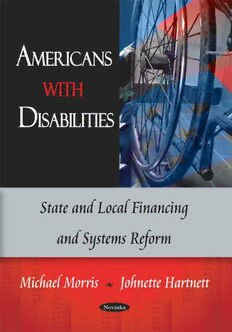
Americans with Disabilities: State and Local Financing and Systems Reform PDF
123 Pages·2009·0.639 MB·English
Most books are stored in the elastic cloud where traffic is expensive. For this reason, we have a limit on daily download.
Preview Americans with Disabilities: State and Local Financing and Systems Reform
Description:
The current picture of long-term services and supports (LTSS) documented by families, policymakers, researchers and service providers is complex, confusing and frustrating. It is a ship struggling with the weight of escalating costs and an increasing number of passengers seeking access and safe passage. Services and supports are scattered throughout numerous federal programs, with uncertain points of entry and different rules of eligibility defined by geography, income level, age, and nature and type of disability. There is no comprehensive national policy focused on LTSS that is free from the medical model and institutional bias of long-term care (LTC).However, at the state and local levels, there is a push to move forward: setting new policies, reallocating resources, testing new service delivery approaches, and engaging individuals with disabilities and families in a public dialogue to redesign the ship to support a consumer-responsive system that encourages choices, seeks flexibility in service delivery, invests in public-private collaboration, and values the role of formal and informal caregivers. None of the highlighted activities can offer a comprehensive roadmap to reform of existing systems. However, each highlighted state or local system focuses a spotlight on innovative thinking, including policies, processes, and methods of administration to help guide the redesign efforts for the future. This book identifies and highlights selected activities at the state and local levels that are leading toward increased access to LTSS with federal and state dollars.A growing number of states are re-evaluating their current systems to identify a range of options for consumers to remain in their own homes or communities rather than be forced into more restrictive environments and skilled nursing facilities. Researchers selected five states to profile and analysed current activities that are in different stages of development toward the goal of comprehensive, person-centred service and support programs.
See more
The list of books you might like
Most books are stored in the elastic cloud where traffic is expensive. For this reason, we have a limit on daily download.
